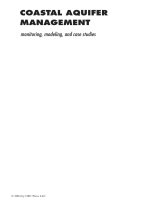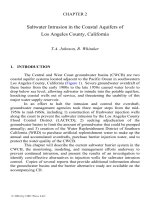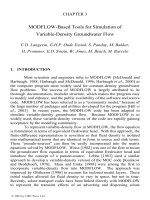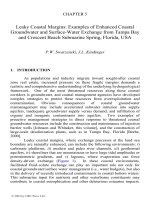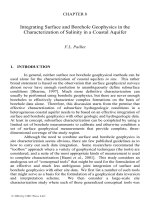Business ethics ethical decision making and case 10e chapter 9
Bạn đang xem bản rút gọn của tài liệu. Xem và tải ngay bản đầy đủ của tài liệu tại đây (6.37 MB, 31 trang )
Part Four
Implementing Business
Ethics in a Global
Economy
Chapter 9
Managing and Controlling Ethics
Programs
© 2015 Cengage Learning. All rights reserved. May not be copied, scanned, or duplicated, in whole or in part,
except for use as permitted in a license distributed with a certain product or service or otherwise on a password-protected website for classroom use.
1
Implementing
Ethics Programs
Five factors can impact success of ethics programs
1.
2.
3.
4.
5.
The content of the code of ethics
The frequency of communication regarding the ethics program
The quality of communication
Senior management’s ability to incorporate ethics into the organization
Local management’s ability to do the same
© 2015 Cengage Learning. All rights reserved. May not be copied, scanned, or duplicated, in whole or in part,
except for use as permitted in a license distributed with a certain product or service or otherwise on a password-protected website for classroom use.
2
Implementing
Ethics Programs
Organizations must focus on implementation and planning an ethics
program
Should be part of strategic planning and management activities
© 2015 Cengage Learning. All rights reserved. May not be copied, scanned, or duplicated, in whole or in part,
except for use as permitted in a license distributed with a certain product or service or otherwise on a password-protected website for classroom use.
3
Process Controls for
Ethics Programs
Proper selection of employees
Ethics training
Structural and communication systems
Ethics assistance line
Help desk
Management’s commitment to the program
Comparing standards against actual behavior
Ethics audit
© 2015 Cengage Learning. All rights reserved. May not be copied, scanned, or duplicated, in whole or in part,
except for use as permitted in a license distributed with a certain product or service or otherwise on a password-protected website for classroom use.
4
The Ethics
Audit
A systematic evaluation of an organization’s ethics program and performance to
determine whether it is effective
Regular, complete, and documented measurements of compliance with policies and
procedures
Can be a precursor to establishing an ethics program
Should be the most important part of an ethics program
Primary purpose is to identify risks and problems in activities and plan steps to
adjust/correct/eliminate concerns
Recent legislation encourages greater ethics audits
© 2015 Cengage Learning. All rights reserved. May not be copied, scanned, or duplicated, in whole or in part,
except for use as permitted in a license distributed with a certain product or service or otherwise on a password-protected website for classroom use.
5
The Social
Audit
The process of accessing and reporting a business’s performance in
fulfilling its economic, legal, ethical, and philanthropic responsibilities
expected by stakeholders
Broader in scope than an ethics audit
An ethics audit might be a component
© 2015 Cengage Learning. All rights reserved. May not be copied, scanned, or duplicated, in whole or in part,
except for use as permitted in a license distributed with a certain product or service or otherwise on a password-protected website for classroom use.
6
Benefits of an
Ethics Audit
Detect misconduct before it becomes a major problem
Identifies potential ethical issues and improve legal compliance
Improve organizational performance
Improve relationships with stakeholders who demand greater transparency
Sets goals against which to measure actual performance
© 2015 Cengage Learning. All rights reserved. May not be copied, scanned, or duplicated, in whole or in part,
except for use as permitted in a license distributed with a certain product or service or otherwise on a password-protected website for classroom use.
7
Top Challenges
For CEOs
1.
Human capital
2.
Operational excellence
3.
Innovation
4.
Customer relationships
5.
Global political/economic risk
6.
Government regulation
7.
Global expansion
N = 729 total responses. Response rate varied for each
8.
Corporate brand and reputation
9.
Sustainability
10.
Trust in business
challenge.
Source: The Conference Board, CEO Challenge® 2013 Summary
Report, 2013.
© 2015 Cengage Learning. All rights reserved. May not be copied, scanned, or duplicated, in whole or in part,
except for use as permitted in a license distributed with a certain product or service or otherwise on a password-protected website for classroom use.
8
Ethical Crisis
Management
Plans to respond to and recover from disasters that can disrupt
operations, destroy organizational reputation, and erode shareholder
confidence
Involves…
Contingency planning
Assessing organizational risks
Planning for potential occurrences
Providing tools to respond
© 2015 Cengage Learning. All rights reserved. May not be copied, scanned, or duplicated, in whole or in part,
except for use as permitted in a license distributed with a certain product or service or otherwise on a password-protected website for classroom use.
9
Stages of an
Ethical Disaster
Ethical misconduct disasters progress in stages
Ethical issue recognition
The decision to act unethically
Organization’s discovery of and response to the act
Anticipation of and intervention can stave off organizational disasters
Formal mechanisms in place to detect risk
© 2015 Cengage Learning. All rights reserved. May not be copied, scanned, or duplicated, in whole or in part,
except for use as permitted in a license distributed with a certain product or service or otherwise on a password-protected website for classroom use.
10
Improving Organizational
Risk Management
1.
Create a Regulatory Reform Project Management Office with the appropriate governance to direct business and
operating models and manage risks proportionately.
2.
Chief Risk Officers should report to Group CROs or board members.
3.
Involve risk and compliance at the beginning of the product development cycle.
4.
Improve independent controls by setting appropriate governance frameworks with which portfolio managers need to
comply.
5.
Manage and optimize the use of capital.
Source: Ernst & Young, Risk Management for Asset Management: Ernst & Young Survey 2012 , 6–7, />$FILE/Risk_Management_for_AM_EY_Survey_2012.pdf (accessed May 14, 2013). 23715_
© 2015 Cengage Learning. All rights reserved. May not be copied, scanned, or duplicated, in whole or in part,
except for use as permitted in a license distributed with a certain product or service or otherwise on a password-protected website for classroom use.
11
Measuring Nonfinancial
Ethical Performance
Nonfinancial performance measures are crucial to a firm’s health
Measure wholeness and soundness of a company
“Return on integrity”
Many organizations and regulatory frameworks offer a means of capturing
ethical performance
Structural
Behavioral
© 2015 Cengage Learning. All rights reserved. May not be copied, scanned, or duplicated, in whole or in part,
except for use as permitted in a license distributed with a certain product or service or otherwise on a password-protected website for classroom use.
12
Description of
Measuring Tools
Measurement Systems
Description
Developed by Drs. Robert Kaplan and David Norton, the Balanced Scorecard incorporates nonfinancial performance indicators into
the evaluation system to provide a more “balanced” view of organizational performance. The system uses four metrics—financial,
Balanced Scorecard
internal business processes, learning and growth, and customer—to measure the overall performance of the firm.
Six Sigma focuses on improving existing processes that do not meet quality specifications or that need to be improved as well as
developing new processes that meet Six Sigma standards. To meet Six Sigma specifications, the process must not produce more than 3.4
Six Sigma
defects per million opportunities.
This approach to measuring social, financial, and environmental factors (or people, places, and planet) recognizes that business has a
responsibility to positively influence a variety of stakeholders, including customers, employees, shareholders, community, and the
natural environment. The challenge is how to evaluate a business’s social and environmental impacts, since there are no universally
Triple Bottom Line
standard forms of measuring these criteria.
Source: “Balanced Scorecard Basics,”Balanced Scorecard Institute, (accessed May 14, 2013); “What is Six Sigma,” iSix
Sigma, (accessed May 14, 2013); “Triple bottom line,” The Economist , November 17, 2009,
(accessed May 14, 2013). 23715_ch09_lores_239-271.indd 249 29/07/13 1:21 PM
© 2015 Cengage Learning. All rights reserved. May not be copied, scanned, or duplicated, in whole or in part,
except for use as permitted in a license distributed with a certain product or service or otherwise on a password-protected website for classroom use.
13
Measuring Nonfinancial
Ethical Performance
Six Sigma
Balanced Scorecard
Triple Bottom Line
Global Reporting Initiative
AccountAbility AA1000 framework
Open Compliance Ethics Group
© 2015 Cengage Learning. All rights reserved. May not be copied, scanned, or duplicated, in whole or in part,
except for use as permitted in a license distributed with a certain product or service or otherwise on a password-protected website for classroom use.
14
AA 1000 Framework for
Ethics and Social Accountability
Source: Adapted from AccountAbility AA1000 Series of Standards, (accessed March 12, 2009). Reprinted with permission of The Institute of Social and Ethical
Accountability.
© 2015 Cengage Learning. All rights reserved. May not be copied, scanned, or duplicated, in whole or in part,
except for use as permitted in a license distributed with a certain product or service or otherwise on a password-protected website for classroom use.
15
AA 1000 Framework for
Ethics and Social Accountability
Source: The Open Compliance Ethics Group Framework Overview, (accessed April 4, 2006). Reprinted with permission.
© 2015 Cengage Learning. All rights reserved. May not be copied, scanned, or duplicated, in whole or in part,
except for use as permitted in a license distributed with a certain product or service or otherwise on a password-protected website for classroom use.
16
Risks in Ethics
Auditing
May uncover ethical problems a company does not wish to disclose
May reveal a problem that cannot be remedied
Stakeholders may be dissatisfied with the information
Conducting ethics audits requires financial and record keeping resources
No guarantee that auditing is the solution
Lack of standardization in auditing
© 2015 Cengage Learning. All rights reserved. May not be copied, scanned, or duplicated, in whole or in part,
except for use as permitted in a license distributed with a certain product or service or otherwise on a password-protected website for classroom use.
17
The Auditing
Process
Audits should be unique to each company
The following steps provide a general framework…
Secure management and board commitment
Establish an ethics audit committee
Define the scope of the audit
Review organizational mission, goals, and values
Collect and analyze relevant information
Verify the results through an outside agent
Report the findings
© 2015 Cengage Learning. All rights reserved. May not be copied, scanned, or duplicated, in whole or in part,
except for use as permitted in a license distributed with a certain product or service or otherwise on a password-protected website for classroom use.
18
Framework for an
Ethics Audit
•
Secure the commitment of top managers and board of directors
•
Establish a committee to oversee the ethics audit
•
Define the scope of the audit process, including subject matter areas important to the ethics audit
•
Review the organization’s mission, policies, goals, and objectives and define its ethical priorities
•
Collect and analyze relevant information in each designated subject matter area
•
Have the results verified by an independent agent
•
Report the findings to the audit committee and, if approved, to managers and stakeholders
Sources: These steps are compatible with the social auditing methods prescribed by Warren Dow and Roy Crowe in What Social Auditing Can Do for Voluntary Organizations (Vancouver: Volunteer Vancouver, July
1999), and Sandra Waddock and Neil Smith in “Corporate Responsibility Audits: Doing Well by Doing Good,” Sloan Management Review 41 (2000), 79.
© 2015 Cengage Learning. All rights reserved. May not be copied, scanned, or duplicated, in whole or in part,
except for use as permitted in a license distributed with a certain product or service or otherwise on a password-protected website for classroom use.
19
Secure Commitment of Top
Management and the Board
The first step in the auditing process
Sarbanes-Oxley requires that boards of directors provide oversight
The board may initiate audits
Managers may request an ethics audit to improve confidence in a firm’s
reporting processes
© 2015 Cengage Learning. All rights reserved. May not be copied, scanned, or duplicated, in whole or in part,
except for use as permitted in a license distributed with a certain product or service or otherwise on a password-protected website for classroom use.
20
Model Corporate Social
Responsibility Structure
© 2015 Cengage Learning. All rights reserved. May not be copied, scanned, or duplicated, in whole or in part,
except for use as permitted in a license distributed with a certain product or service or otherwise on a password-protected website for classroom use.
21
Establish an Ethics
Oversight Committee
The second step in the auditing process
Boards of directors financial audit committee should oversee the audit
Managers or ethics officers conduct it in most firms
Internal and external parties should be involved
External auditors should not have other consulting or conflict-of-interest relationships
with top managers or board members
© 2015 Cengage Learning. All rights reserved. May not be copied, scanned, or duplicated, in whole or in part,
except for use as permitted in a license distributed with a certain product or service or otherwise on a password-protected website for classroom use.
22
Define the Scope
of the Audit
The ethics audit committee should establish the scope of the audit and
monitor its progress
Scope is determined by the type of business, risks faced, and the opportunities
to manage ethics
© 2015 Cengage Learning. All rights reserved. May not be copied, scanned, or duplicated, in whole or in part,
except for use as permitted in a license distributed with a certain product or service or otherwise on a password-protected website for classroom use.
23
Review Organizational Mission, Values, Goals, and Policies
An ethics audit should…
Include a review of the current mission statement and strategic objectives
A firm should define its ethical priorities at this time
Examine all formal and informal documents that make commitments with
regard to ethical, legal, or social responsibility
© 2015 Cengage Learning. All rights reserved. May not be copied, scanned, or duplicated, in whole or in part,
except for use as permitted in a license distributed with a certain product or service or otherwise on a password-protected website for classroom use.
24
Collect and Analyze
Information
Identify tools for measuring progress in improving employees’ ethical
decisions
Collect relevant subject matter
Internal and external documents
Determine a baseline level of compliance
© 2015 Cengage Learning. All rights reserved. May not be copied, scanned, or duplicated, in whole or in part,
except for use as permitted in a license distributed with a certain product or service or otherwise on a password-protected website for classroom use.
25

